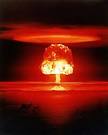| Date | Text | |
|---|---|---|
03 Oct 1952

Videotape recording |
Videotape recording In 1952, the first U.S. video recording on magnetic tape giving credible results of off-air black and white recordings was made by John T. Mullin at the electronics division of Bing Crosby Enterprises, Inc., Los Angeles, Cal. Using a Video Tape Recorder, the images on magnetic tape were not only one-third less costly than photographic methods, but were also immediately available to reproduce on a standard TV monitor tube as soon as the tape was rewound. The 12-head VTR used one-inch tape running at 120 inches per second to record ten tracks of monochrome video information, a clock track to control synchronization and an FM audio track. The basic theory was to use frequency division multiplexing with the 10 channels covering the desired video range. |
|
03 Oct 1952

First UK atom bomb test |
First UK atom bomb test In 1952, “Hurricane,” the first British atomic bomb was tested at the Monte Bello, Australia, becoming the third country in the world to test such a weapon. The bomb used an improved plutonium implosion bomb similar to the U.S. "Fat Man". The bomb used plutonium produced in Britain at Windscale (now Sellafield) with a low Pu-240 content since hurried production led to short irradiation times, plus some Canadian origin plutonium. To test the effects of a ship-smuggled bomb (a threat of great concern at the time), Hurricane was exploded inside the hull of the HMS Plym (1450 ton frigate) which was anchored in 40 feet of water 400 yards off shore. The explosion, 9-ft below the water line, left a saucer-shaped crater on the seabed 20-ft deep and 1,000-ft across. |